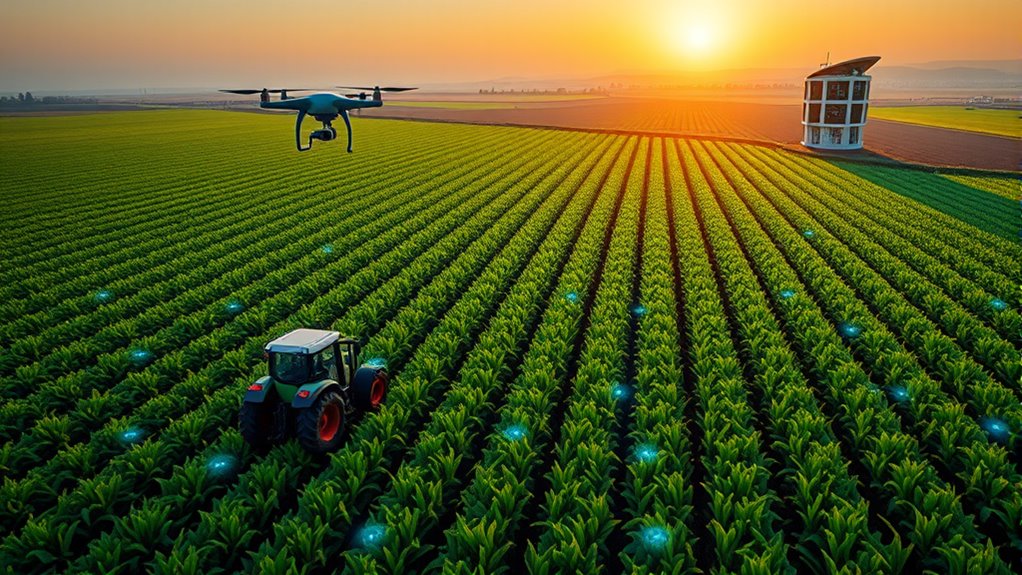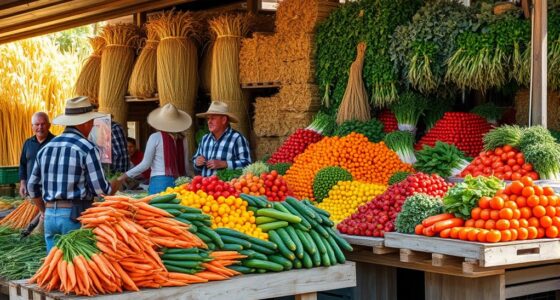By 2025, AI is revolutionizing agriculture through precision farming, allowing you to monitor crops with drones and advanced imaging. You can detect pests, diseases, and nutrient deficiencies early, reducing chemical use and boosting yields. Automated systems optimize fertilizer and pesticide application, making farming more sustainable and cost-effective. These technologies adapt to seasonal changes and environmental conditions, helping you stay ahead of challenges. Continue exploring to uncover more innovative ways AI can transform your farming practices.
Key Takeaways
- AI-powered crop monitoring enables early detection of pests and diseases, promoting targeted and eco-friendly interventions.
- Drone automation provides real-time aerial data for efficient large-scale farmland assessments.
- Integration of AI with drone data enhances early problem detection and supports precise, less invasive treatments.
- Automated precision farming combines drone surveillance with automated spraying, reducing waste and increasing yields.
- AI-driven insights support sustainable practices, resource conservation, and resilience against climate challenges for 2025 and beyond.

Artificial intelligence is transforming agriculture by making farming more efficient, sustainable, and productive. One of the most significant ways AI is achieving this is through advanced crop monitoring. Instead of relying solely on manual inspections, you can now use AI-powered tools to analyze images and data collected from your fields. These systems can quickly identify issues like pest infestations, disease outbreaks, or nutrient deficiencies, allowing you to react faster and target treatments precisely where needed. This not only improves crop health but also reduces the use of chemicals, promoting eco-friendly practices.
Another major advancement is drone automation, which is changing how you oversee large farmland areas. Drones equipped with AI capabilities can fly over your fields, capturing high-resolution images and multispectral data. These aerial surveys give you real-time insights into crop conditions, soil variability, and water stress, all without putting you or your team in harm’s way. With drone automation, you can schedule regular flights that gather consistent data, helping you track growth patterns and identify problems before they become serious. This level of precision farming means you can maximize input use—watering, fertilizing, and pest control—saving costs while boosting yields.
Drones with AI capture real-time, high-resolution data for precise farming and early problem detection, boosting efficiency and yields.
AI-driven crop monitoring and drone automation work hand-in-hand to create a thorough picture of your farm’s health. For example, AI algorithms process the images captured by drones to detect early signs of disease or pest activity, often before you could see them with the naked eye. This early detection lets you act immediately, applying targeted treatments that are less invasive and more effective. Because these systems constantly learn and improve from new data, your farm’s monitoring becomes more accurate over time, adapting to seasonal changes and emerging threats. Incorporating cultural intelligence strategies can further enhance your ability to interpret and respond to these data, ensuring that your management practices are culturally appropriate and sustainable.
Furthermore, drone automation isn’t just about surveillance; it can also be integrated with automated spraying systems, allowing precise application of fertilizers or pesticides. This reduces waste, minimizes environmental impact, and ensures your crops receive exactly what they need for peak growth. As you incorporate AI into crop monitoring and drone operations, you gain a strategic advantage—saving time, lowering costs, and increasing productivity. These technologies are shaping the future of farming, making it more sustainable and resilient against the challenges of climate change and resource scarcity.
Frequently Asked Questions
How Will AI Impact Small-Scale Farmers Financially?
AI will positively impact your finances by providing economic benefits through improved crop yields and resource efficiency. As you adopt new technology, you’ll likely reduce costs on inputs like water, fertilizer, and labor. This increased efficiency can lead to higher profits, making AI a valuable tool for small-scale farmers. Embracing these innovations now can strengthen your farm’s sustainability and competitiveness in the evolving agricultural landscape.
What Are the Privacy Concerns With AI Data Collection?
You might worry about your farm’s data privacy, but it’s mainly about safeguarding your information. Data security guarantees your sensitive details stay protected, while consent management gives you control over who accesses your data. Be aware that AI systems collect and analyze your farm data, so understanding privacy policies and managing permissions help you stay in charge — keeping your farm’s insights safe and respecting your privacy boundaries.
How Is AI Training Data for Agriculture Sourced Ethically?
You guarantee AI training data for agriculture is ethically sourced by prioritizing ethical sourcing practices, like obtaining consent from farmers and respecting local regulations. You promote data transparency by clearly communicating how data is collected, used, and stored. This approach builds trust, safeguards farmers’ rights, and helps prevent misuse of sensitive information. By adhering to these principles, you contribute to responsible AI development that benefits everyone involved.
Will AI Replace Human Farm Labor Entirely?
AI won’t replace human farm labor entirely, but you’ll see automation concerns grow. Imagine a tractor that works tirelessly, yet still needs a farmer’s eye for detail and judgment. While AI can handle repetitive tasks, labor displacement is unlikely to eliminate jobs completely. Instead, it shifts roles, allowing you to focus on more complex, strategic aspects of farming. Your expertise remains essential in guiding technology’s integration into agriculture.
How Do AI Innovations Affect Agricultural Biodiversity?
AI innovations can positively affect agricultural biodiversity by helping you monitor and preserve genetic diversity in crops and livestock. When you use AI-driven tools to identify resilient gene traits, you enhance ecosystem resilience, making farms more adaptable to environmental changes. This technology encourages diversification, reducing reliance on monocultures, and ultimately supports a healthier, more balanced ecosystem, benefiting both productivity and sustainability.
Conclusion
As you embrace these AI-driven innovations, you’re planting the seeds for a future where farming blooms with efficiency and sustainability. By 2025, precision farming will be your compass through the fields, guiding you like a trusted lighthouse in the fog. The power of AI transforms agriculture into a well-oiled machine, turning your efforts into a lush harvest. Stay ahead of the curve, and watch your farm flourish like a vibrant tapestry woven with technology.









